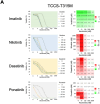Synergistic effect of asciminib with reduced doses of ponatinib in human Ph + myeloid leukemia with the T315M mutation
- PMID: 40208408
- PMCID: PMC12304016
- DOI: 10.1007/s12185-025-03981-7
Synergistic effect of asciminib with reduced doses of ponatinib in human Ph + myeloid leukemia with the T315M mutation
Abstract
In Philadelphia chromosome-positive (Ph +) leukemia, substitution of threonine at the 315 position of BCR::ABL1 with isoleucine (T315I) induces severe resistance to tyrosine kinase inhibitors (TKIs). Of clinical importance, the substitution of the baseline T315I mutation by methionine (I315M) was reported in a Ph + leukemia patient treated with ponatinib. The resultant T315M mutation induces severe TKI-resistance in a murine Ba/F3 model. Asciminib, an allosteric inhibitor of BCR::ABL1, is reportedly active in ponatinib-resistant patients with the T315I mutation. Although asciminib alone is not active in a murine Ba/F3 model with the T315M mutation, asciminib and ponatinib show synergistic activities. In the present study, we introduced the T315M mutation into the intrinsic BCR::ABL1 gene of two Ph + myeloid and one Ph + lymphoid leukemia cell lines using the CRISPR/Cas9 system to directly verify the utility of the combined asciminib and ponatinib in human models. All three T315M-acquired sublines were more resistant to TKIs including ponatinib than T315I-acquired sublines. Notably, asciminib exhibited a stronger synergistic effect with reduced doses of ponatinib in the T315M-acquired sublines of two myeloid cell lines, but not in the lymphoid cell line. This indicates that the combination of ponatinib and asciminib may have a clinical utility in human Ph + myeloid leukemia.
Keywords: CRISPR/Cas9; Philadelphia chromosome-positive leukemia; Synergistic effect; T315M mutation; Tyrosine kinase inhibitor resistance.
© 2025. The Author(s).
Conflict of interest statement
Declarations. Conflict of interest: The authors declare no conflicts of interest.
Figures






References
-
- Apperley JF. Chronic myeloid leukemia. Lancet. 2015;385:1447–59. - PubMed
-
- O’Hare T, Zabriskie MS, Eiring AM, Deininger MW. Pushing the limits of targeted therapy in chronic myeloid leukemia. Nat Rev Cancer. 2012;12:513–26. - PubMed
-
- Gorre ME, Mohammed M, Ellwood K, Hsu N, Paquette R, Rao PN, et al. Clinical resistance to STI-571 cancer therapy caused by BCR-ABL gene mutation or amplification. Science. 2001;293:876–80. - PubMed
MeSH terms
Substances
Grants and funding
LinkOut - more resources
Full Text Sources
Medical
Miscellaneous

